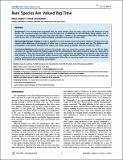Por favor, use este identificador para citar o enlazar a este item:
http://hdl.handle.net/10261/45433COMPARTIR / EXPORTAR:
 SHARE SHARE
 CORE
BASE CORE
BASE
|
|
| Visualizar otros formatos: MARC | Dublin Core | RDF | ORE | MODS | METS | DIDL | DATACITE | |

| Campo DC | Valor | Lengua/Idioma |
|---|---|---|
| dc.contributor.author | Angulo, Elena | - |
| dc.contributor.author | Courchamp, Franck | - |
| dc.date.accessioned | 2012-02-13T09:35:43Z | - |
| dc.date.available | 2012-02-13T09:35:43Z | - |
| dc.date.issued | 2009-04 | - |
| dc.identifier.citation | PLoS ONE 4(4): e5215. | es_ES |
| dc.identifier.uri | http://hdl.handle.net/10261/45433 | - |
| dc.description.abstract | Background: It has recently been postulated that the value humans place on rarity could cause the extinction of rare species. This is because people are willing to pay the high costs of exploiting the last individuals. Many hobbies, such as ecotourism or the keeping of exotic pets may cause this effect – known as the anthropogenic Allee effect. However, the entire theory relies on the insofar undemonstrated assumption that people do value rarity. Methodology/Principal Findings: In order to quantify how much people valued rare species relative to common ones, we created online slideshows of photographs of either rare or common species on an Internet web site. The slideshow with photographs of rare species attracted more visitors, and visitors spent, in general, more time waiting to view it. Conclusions/Significance: We provide evidence that people value rare more than common species. As we did not target consumers of a specific market, this finding suggests that the anthropogenic Allee effect is likely be driven by a large part of the population. Given the substantial participation in our online experiment, we highlight the potential of the world wide web resource as a tool for conservation action. However, the evidence presented here that the general public value rare species, combined with the assumption that anthropogenic Allee effect is operating, implies that conservationists should be prudent when using rarity to promote conservation. | es_ES |
| dc.language.iso | eng | es_ES |
| dc.publisher | Public Library of Science | es_ES |
| dc.relation.isversionof | Publisher's version | - |
| dc.rights | openAccess | es_ES |
| dc.title | Rare Species Are Valued Big Time | es_ES |
| dc.type | artículo | es_ES |
| dc.identifier.doi | 10.1371/journal.pone.0005215 | - |
| dc.description.peerreviewed | Peer reviewed | es_ES |
| dc.relation.publisherversion | http://www.plosone.org/article/info%3Adoi%2F10.1371%2Fjournal.pone.0005215 | es_ES |
| dc.identifier.pmid | 19384416 | - |
| dc.type.coar | http://purl.org/coar/resource_type/c_6501 | es_ES |
| item.openairetype | artículo | - |
| item.grantfulltext | open | - |
| item.cerifentitytype | Publications | - |
| item.openairecristype | http://purl.org/coar/resource_type/c_18cf | - |
| item.fulltext | With Fulltext | - |
| item.languageiso639-1 | en | - |
| Aparece en las colecciones: | (EBD) Artículos | |
Ficheros en este ítem:
| Fichero | Descripción | Tamaño | Formato | |
|---|---|---|---|---|
| 38662719.pdf | 157,7 kB | Adobe PDF |  Visualizar/Abrir |
CORE Recommender
PubMed Central
Citations
9
checked on 05-abr-2024
SCOPUSTM
Citations
44
checked on 12-abr-2024
WEB OF SCIENCETM
Citations
41
checked on 23-feb-2024
Page view(s)
308
checked on 19-abr-2024
Download(s)
162
checked on 19-abr-2024
Google ScholarTM
Check
Altmetric
Altmetric
Artículos relacionados:
NOTA: Los ítems de Digital.CSIC están protegidos por copyright, con todos los derechos reservados, a menos que se indique lo contrario.
